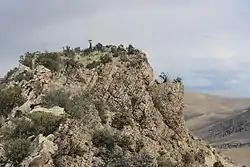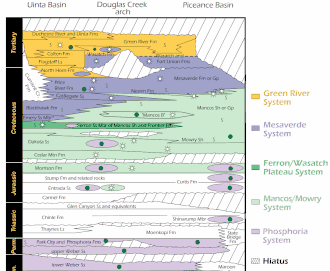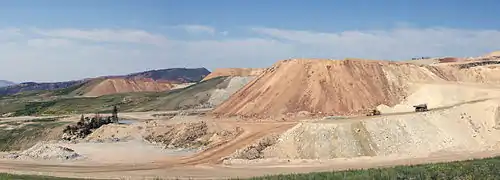| Phosphoria Formation | |
|---|---|
Stratigraphic range: | |
 | |
| Type | Geological formation |
| Underlies | Dinwoody Formation |
| Overlies | Casper Formation, Park City Formation, Tensleep Sandstone |
| Area | 350,000 sq. km (140,000 sq. mi)[1] |
| Thickness | Up to 420 metres (1,380 ft)[1] |
| Lithology | |
| Primary | Limestone, dolomite, shale |
| Other | Chert, phosphorite, sandstone |
| Location | |
| Region | Idaho, Montana, Utah, Wyoming[2] |
| Country | |
| Type section | |
| Named for | Phosphoria Gulch, Idaho |
| Named by | Richards and Mansfield, 1912[3] |

The Phosphoria Formation of the western United States is a geological formation of Early Permian age.[4] It represents some 15 million years of sedimentation, reaches a thickness of 420 metres (1,380 ft) and covers an area of 350,000 square kilometres (140,000 sq mi).[1]
The Phosphoria includes phosphorite beds that are an important source of phosphorus.[5] Many of its shales are rich in organic matter and are petroleum source rocks,[6] and some of its dolomites include petroleum reservoirs.[7]
Environment of deposition
The Phosphoria Formation was deposited under marine conditions in a foreland basin located between the Paleozoic continental margin and the North American cratonic shelf.[6] The upwelling of cold, nutrient-rich marine water at that time stimulated the growth of plankton and nekton, resulting in the accumulation of organic matter on the sea floor. That, coupled with low rates of clastic and carbonate sedimentation, led to the high phosphate and hydrocarbon content of the formation, as well as elevated levels of cadmium, chromium, copper, fluorine, molybdenum, nickel, rare earth elements, selenium, uranium, vanadium, and zinc.[5][8]
Stratigraphy and lithology
The formation is commonly subdivided, from the top downward, as follows:
- The Tosi chert member (chert with limestone at base).
- The Retort phosphatic member (phosphorite, dolomite, and siltstone).
- The Rex chert member (gray limestone at base, black chert, and black cherty shale).
- The Meade Peak phosphatic member (interbedded brown to black shale, gray dense limestone, dark brown oolitic phosphorite, and minor white calcareous sandstone).
- The Lower Chert member (dark cherty shale).
The Phosphoria is underlain by the Pennsylvanian-Permian Casper Formation[1] or, depending on the location, by the Park City Formation or the Tensleep Sandstone,[5] and it is overlain by the Triassic Dinwoody Formation.[1] The upper boundary is placed at the top of the uppermost phosphorite bed and below the tan calcareous siltstone of Dinwoody formation. The lower boundary is marked by a thin phosphorite that contains abundant fish scales and bones.[2][5]
Thickness and distribution
The formation reaches its greatest thickness in the Sublett Range in the Paleozoic cordilleran structural basin of southern Idaho. Within the basin the formation consists of a basal phosphorite overlain by a thick sequence of chert and cherty sandstone. To the east in western Wyoming the Phosphoria gradually decreases in thickness and is intertongued with carbonate rocks of the Park City Formation and redbed sandstones of the Chugwater Formation of Permian to Triassic age.[1] The Phosphoria units extend into the Wind River Mountains and pinch out in the Green Mountains to the east.[1]
Paleontology
_in_phosphatic_limestone_(Phosphoria_Formation%252C_mid-Permian%253B_Waterloo_Mine%252C_near_Montpelier%252C_Idaho%252C_USA)_1_(34367874135).jpg.webp)
Fossils recovered from the Phosphoria Formation include brachiopods, sponge spicules, crinoid stems, conodont elements, and fish scales and bones. Most "tooth whorls" of the enigmatic cartilaginous fish Helicoprion are known from the formation, including the only known specimen with preserved cranial remains. The Early Permian age of the formation is based primarily on conodont biostratigraphy.[2][3][4][9]
Economic resources
Phosphorus

The Phosphoria phosphorite beds have been mined for phosphorus, which is used primarily for fertilizer production, in southeastern Idaho, northern Utah, western Wyoming, and southwestern Montana.[5]
Uranium
Low concentrations of uranium are present in the Phosphoria phosphorite beds[10] but are not considered to be of economic interest.[11]
Vanadium
A vanadium-enriched zone that is present in western Wyoming and southeastern Idaho[12] contains potentially economic concentrations of vanadium in some areas.[13]
Petroleum
Petroleum has been produced from some of the dolomites in the Phosphoria Formation,[7] and many of the Phosphoria shales are rich in organic matter and are petroleum source rocks.[6]
See also
References
- 1 2 3 4 5 6 7 Blatt, Harvey and Robert J. Tracy, Petrology, Freeman, 1996, 2nd ed. pp. 345-349 ISBN 0-7167-2438-3
- 1 2 3 U.S. Geological Survey. "Geologic Unit: Phosphoria". Retrieved 2014-12-23.
- 1 2 Richards, R.W., and Mansfield, G.R., 1912, The Bannock overthrust; a major fault in southeastern Idaho and northeastern Utah: Journal of Geology, v. 20, no. 8, p. 681-709.
- 1 2 Behnken, F.H., Wardlaw, B.R. and Stout, L.N., 1986, Conodont biostratigraphy of the Permian Meade Peak Phosphatic Shale Member, Phosphoria Formation, southeastern Idaho. University of Wyoming Contributions to Geology, v. 24, no. 2, p. 169-190.
- 1 2 3 4 5 McKelvey, V.E., Cheney, T.M., Cressman, E.R., Sheldon, R.P., Swanson, R.W. and Williams, J. Steele, 1959. The Phosphoria, Park City, and Shedhorn formations in the western phosphate field. In: Geology of Permian rocks in the western phosphate field, U.S. Geological Survey Professional Paper 313-A, p. A1-A47.
- 1 2 3 Maughan, E.K. 1984. Geological setting and some geochemistry of petroleum source rocks in the Permian Phosphoria Formation. Rocky Mountain Association of Geologists.
- 1 2 Campbell, C.V. 1962. Depositional environments of Phosphoria Formation (Permian) in southeastern Bighorn basin, Wyoming. AAPG Bulletin 46(4): 478-503.
- ↑ Piper, D.Z. and Medrano, M.D. 1994. Geochemistry of the Phosphoria Formation at Montpelier Canyon, Idaho. United States Geological Survey, Bulletin 2023-B, 28 p.
- ↑ Wardlaw, B.R. and J.W. Collinson, 1986. Paleontology and deposition of the Phosphoria Formation. Rocky Mountain Geology 24(2): 107-142.
- ↑ McKelvey, V.E., and L.D. Carswell, 1967. Uranium in the Phosphoria Formation. In: Anatomy of the Western Phosphate Field: A Guide to the Geologic Occurrence, Exploration Methods, Mining Engineering and Recovery Technology; AAPG Fifteenth Annual Field Conference, p. 119-123.
- ↑ Finch, Warren I. (1996) Uranium provinces of North America-their definition, distribution, and models, US Geological Survey, Bulletin 2141.
- ↑ McKelvey, V.E., Strobell Jr, J.D. and Slaughter, A.L., 1987. The vanadiferous zone of the Phosphoria Formation in western Wyoming and southeastern Idaho. In: The Thrust Belt Revisited; AAPG 38th Annual Field Conference Guidebook, p. 305-308.
- ↑ "Rocky Mountain to sell Paris Hills phosphate/vanadium property in Idaho", Proactive Investors, 12 Oct. 2009.
